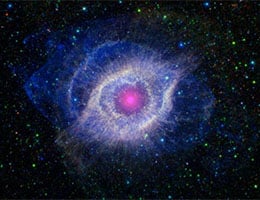 The concept of nebula is used in the field of astronomy to refer to cosmic matter formed by a combination of gases and dust , whose limits are not precise. The nebula, a term that derives from the Latin word nebulōsus , can take on different shapes.
The concept of nebula is used in the field of astronomy to refer to cosmic matter formed by a combination of gases and dust , whose limits are not precise. The nebula, a term that derives from the Latin word nebulōsus , can take on different shapes.
Helium and hydrogen are the most common components of nebulae. This matter can be generated from the remains of stars that have already become extinct , although it can also constitute the ingredient that gives rise to new stars through a process of aggregation and condensation .
Emission nebulae are the most common. In these nebulae, the gases are transformed by ultraviolet radiation from the closest stars, and that is why they shine brightly. In the field of astrophysics , these nebulae are called H II Regions and are an essential element in the analysis of the physical properties and chemical composition of nebulae.
One of the reasons why emission nebulae are so important to astrophysics is the large number of emission lines of their chemical elements. The brightest and most relevant of them is H-alpha , which is found in the red zone of the spectrum and explains why this color predominates in the images captured of these nebulae.
Absorption nebulae or dark nebulae , on the other hand, are far from the stars and are not under their influence: therefore they do not emit light. They are accumulations of interstellar dust and gas that are not related to any star, and it is for this reason that they do not receive energy and their presence can only be noticed by contrasting them with a very starry background that is at a great distance.
In the peripheral zone of an absorption nebula, the stars behind it exhibit a reddish color and lower intensity precisely because the material of the former tends to absorb their light . Because some absorption nebulae are between our galaxy and the Sun, on moonless nights it is possible to see certain "spots" in the sky.
 Some of the easiest absorption nebulae to distinguish in our galaxy are Coalbag and Horsehead (the latter can be seen with a medium-sized telescope, which is why many people know it). It is worth mentioning that in other galaxies, beyond our own, nebulae of this type also exist. If they are studied using infrared radiation, stars forming within them are sometimes detected.
Some of the easiest absorption nebulae to distinguish in our galaxy are Coalbag and Horsehead (the latter can be seen with a medium-sized telescope, which is why many people know it). It is worth mentioning that in other galaxies, beyond our own, nebulae of this type also exist. If they are studied using infrared radiation, stars forming within them are sometimes detected.
Reflection nebulae , finally, manage to reflect the light of the closest stars, but since they are not too hot, they do not emit the ultraviolet radiation that is required for the excitation of the gas in the nebula. In general, they are made up of residues of the gas that originated the star and their spectrum is similar to that of those whose light they reflect. The best known of this type is the nebula found around Merope , a star in the Seven Sisters open cluster, belonging to the constellation of Taurus .
Beyond the astronomical, the idea of nebula is used to refer to that which develops in an unclear manner and to the state of confusion or hesitation . These meanings are linked to the first uses of nebula which, until the creation of the telescope , referred to celestial bodies that appeared diffuse before the observer's eyes.
For example : "My brother-in-law told me yesterday about a business initiative, but it seemed a little nebulous to me," "Could you tell me what's going on here?" "I'm in a nebula."
